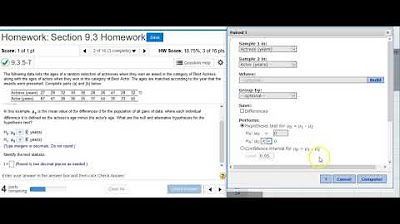Finding the best point estimate and confidence interval for proportions
TLDRIn this informative video, Professor Curtis from Aspire Mountain Academy offers a step-by-step guide on how to calculate the best point estimate and confidence interval for proportions using sample data. The video tackles a specific problem involving an internet survey on cellphone use and brain hemispheric dominance, where 1064 out of 2606 randomly selected subjects responded. Professor Curtis demonstrates the process of constructing a 90% confidence interval using StatCrunch software, emphasizing the importance of selecting the correct confidence level to avoid errors. He clarifies the concept of margin of error and standard error, and provides a clear explanation of what a confidence interval represents. The video concludes with an exercise to choose the correct interpretation of a confidence interval, reinforcing the idea that it reflects a 90% certainty that the true population proportion lies within the interval's bounds. The engaging presentation encourages viewers to engage with the content and seek further learning opportunities through Aspire Mountain Academy.
Takeaways
- 📚 Professor Curtis is providing statistics homework help on finding the best point estimate and confidence interval for proportions.
- 📉 The problem involves a study on cellphone use and brain hemispheric dominance, with a sample of 2606 subjects and 1064 returned surveys.
- 🔢 To construct a 90% confidence interval for the proportion of returned surveys, use the sample data and confidence level provided.
- 💻 Professor Curtis uses StatCrunch software to calculate the confidence interval, emphasizing its ease of use over manual calculations.
- 📐 The sample proportion is calculated by dividing the number of successful returns (1064) by the total number of observations (2606).
- 🚫 The standard error shown in the software is not the margin of error; the margin of error is the distance from the point estimate to the lower limit of the confidence interval.
- 📈 The point estimate is the sample proportion itself, which is calculated within StatCrunch for convenience.
- 🔄 To avoid rounding errors, subtract the lower limit of the confidence interval from the point estimate to find the margin of error.
- 🔍 Before moving on, ensure that the correct confidence level is set in the options to avoid discrepancies in the results.
- 🗣️ The confidence interval is a range within which we are certain that the true population parameter lies, at a given confidence level.
- ✅ The correct interpretation of a 90% confidence interval is that we are 90% confident that the true value of the population proportion is between the interval's bounds.
- 📝 For further assistance or feedback, students are encouraged to visit Aspire Mountain Academy's website or leave comments below the video.
Q & A
What is the main topic of the video?
-The main topic of the video is how to find the best point estimate and confidence interval for proportions using sample data and a given confidence level.
What is the context of the problem statement provided in the video?
-The problem statement is about a study on cell phone use and brain hemispheric dominance where an internet survey was emailed to 2606 subjects, and 1064 surveys were returned. The task is to construct a 90% confidence interval for the proportion of returned surveys.
Why does Professor Curtis decide to use StatCrunch for this problem?
-Professor Curtis decides to use StatCrunch to simplify the process of calculating the confidence interval, as it offers the functionality to easily perform these statistical operations without manually doing extensive calculations.
What is the definition of 'success' in the context of the survey?
-In the context of the survey, 'success' is defined as the return of a survey, meaning that a participant completed and sent back the survey.
How does StatCrunch calculate the sample proportion?
-StatCrunch calculates the sample proportion by dividing the number of successes (returned surveys) by the total number of observations (total surveys sent out).
What is the margin of error and how is it calculated?
-The margin of error is the range within which the true population value is likely to fall. It is calculated by subtracting the lower limit of the confidence interval from the point estimate or by subtracting the point estimate from the upper limit of the confidence interval.
Why might students get different results when following the steps provided?
-Students might get different results if they use the wrong confidence level in their calculations. It's important to ensure that the correct confidence level is set in the options window of the statistical software being used.
How should a confidence interval be correctly interpreted?
-A confidence interval indicates that we are a certain percentage (e.g., 90%) confident that the true value of the population parameter lies between the upper and lower limits of the interval.
What is the correct interpretation of a 90% confidence interval?
-A 90% confidence interval means that if we were to repeat the sampling process an infinite number of times, 90% of the confidence intervals calculated from those samples would contain the true population proportion.
Why is it important to check the answer options carefully when interpreting a confidence interval?
-It is important to check the answer options carefully to ensure that the interpretation aligns with statistical principles. Misinterpretations can lead to incorrect conclusions about the confidence interval's meaning.
What advice does Professor Curtis give for improving statistical understanding?
-Professor Curtis suggests visiting Aspire Mountain Academy's website for lecture videos and additional resources if a student's statistics teacher is not engaging or helpful.
How can viewers provide feedback or ask for help with their statistics learning?
-Viewers can provide feedback or ask for help by leaving comments below the video and visiting the Aspire Mountain Academy website for more information on accessing lecture videos.
Outlines
📊 Finding the Best Point Estimate and Confidence Interval for Proportions
Professor Curtis from Aspire Mountain Academy introduces the topic of finding the best point estimate and confidence interval for proportions using sample data and a given confidence level. The example provided involves a study on cellphone use and brain hemispheric dominance, where an internet survey was sent to 2606 subjects, with 1064 responses returned. The professor demonstrates how to use StatCrunch to construct a 90% confidence interval for the proportion of returned surveys, emphasizing the importance of using the correct confidence level and understanding the difference between the standard error and the margin of error. The video also covers how to calculate the margin of error and the correct interpretation of a confidence interval.
💡 Correct Interpretation of Confidence Intervals and Common Pitfalls
The second paragraph addresses common issues students face when interpreting confidence intervals, particularly the importance of setting the correct confidence level to avoid incorrect results. The professor explains that the confidence interval represents a range of values within which we can be confident the true population parameter lies. It is clarified that a 90% confidence interval means there is a 90% probability that the true value of the population proportion is between the interval's upper and lower bounds. The video instructs viewers on how to choose the correct answer option that reflects this understanding and reminds them to check all answer options before making a selection. The video concludes with an invitation for feedback and further learning opportunities at Aspire Mountain Academy.
Mindmap
Keywords
💡Point Estimate
💡Confidence Interval
💡Margin of Error
💡Standard Error
💡Population Parameter
💡Sample Proportion
💡Statistical Software
💡Confidence Level
💡Survey Response Rate
💡Z-Score Table
💡Statistical Significance
Highlights
Professor Curtis from Aspire Mountain Academy provides statistics homework help on finding the best point estimate and confidence interval for proportions.
A study on cell phone use and brain hemispheric dominance is presented, with an internet survey emailed to 2606 subjects and 1064 responses returned.
A 90% confidence interval for the proportion of returned surveys is to be constructed using sample data.
StatCrunch software is used for its functionality to calculate the confidence interval, rather than manual calculations.
The sample proportion is calculated within StatCrunch by dividing the number of successes (returned surveys) by the total number of observations.
The margin of error is not the same as the standard error and is derived by subtracting the lower limit of the confidence interval from the point estimate.
To avoid rounding errors, it's recommended to perform calculations using all available digits before rounding.
Students sometimes get incorrect results due to using the wrong confidence level in their calculations.
The correct interpretation of a confidence interval is that there is a certain level of confidence that the true population parameter lies between the interval's bounds.
Answer options are provided to choose the correct interpretation of a confidence interval, with option A being the correct choice.
The confidence interval does not imply that 90% of sample proportions will fall between the bounds, but rather that there is 90% confidence the true value does.
The video emphasizes the importance of using the correct confidence level to avoid incorrect results.
StatCrunch automates the calculation of the sample proportion and confidence interval, simplifying the process for students.
The video provides a step-by-step guide on how to input data and select options in StatCrunch to find the confidence interval.
Professor Curtis suggests that using software like StatCrunch can help students understand the steps to find a confidence interval, even if they are not manually calculating.
The video clarifies the common mistake of confusing the standard error with the margin of error and explains how to correctly calculate the margin of error.
The importance of checking the confidence level in software to ensure accurate results is emphasized, as it is a common source of error.
The video concludes with an invitation for feedback and an offer to help students who find their statistics teacher unhelpful or uninteresting, directing them to Aspire Mountain Academy's resources.
Transcripts
Browse More Related Video

Finding the sample size needed to estimate a confidence interval on a population mean

Finding a confidence interval given summary sample data

Finding a sample proportion and the corresponding confidence interval

Finding and interpreting a confidence interval for a population mean (σ unknown)

Finding degrees of freedom, critical values, and a standard deviation confidence interval estimate

Using StatCrunch to perform hypothesis testing on two matched pair means of acting award ages
5.0 / 5 (0 votes)
Thanks for rating: